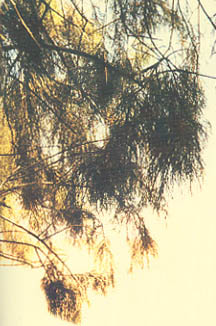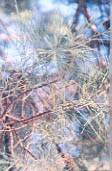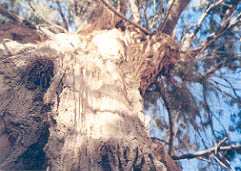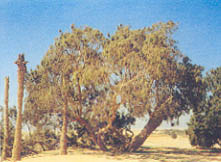Mystical, mythical, call them what you may.
High on the wanted list is the Tamarisk tree, a.k.a. the Salt Cedar, which can be a heaven
sent life saver to some, but a two faced, greedy, selfish, indestructible son of a seed to
others.
 A long time ago in the North of Sinai, Moses threw yet
another stick through the air and, at the spot at where it landed, 12 springs appeared.
These 12 springs represented the 12 tribes wandering aimlessly about Sinai looking for
their promised land. Since they must have been pretty thirsty by now, the springs proved
very useful. However, the tribes were also pretty hungry too, and miraculously 12 bunches
of trees popped up around the springs as well. Growing up to 5 metres tall, the shrubby
branches of these larger trees covered in silky hair take on the appearance of a natural
candyfloss, ideally suitable fodder for the children of Israel. However, it’s not the
leaves and branches we’re interested in. Flowering in springtime, the pale pink 5
petaled buds attract multitudes of small hungry sap-sucking bees who turn the toxic sap
into a sweet honey substance, originally called "Man Hu" in Hebrew, meaning
" what is it", but better known to us now as Manna, the food which came from
Heaven. This wafery substance is then baked into cakes, occasionally accompanied by a
Sinai partridge, or Saloua, and probably a glass of water from the spring. That is, if
there’s any water left in the spring.
A long time ago in the North of Sinai, Moses threw yet
another stick through the air and, at the spot at where it landed, 12 springs appeared.
These 12 springs represented the 12 tribes wandering aimlessly about Sinai looking for
their promised land. Since they must have been pretty thirsty by now, the springs proved
very useful. However, the tribes were also pretty hungry too, and miraculously 12 bunches
of trees popped up around the springs as well. Growing up to 5 metres tall, the shrubby
branches of these larger trees covered in silky hair take on the appearance of a natural
candyfloss, ideally suitable fodder for the children of Israel. However, it’s not the
leaves and branches we’re interested in. Flowering in springtime, the pale pink 5
petaled buds attract multitudes of small hungry sap-sucking bees who turn the toxic sap
into a sweet honey substance, originally called "Man Hu" in Hebrew, meaning
" what is it", but better known to us now as Manna, the food which came from
Heaven. This wafery substance is then baked into cakes, occasionally accompanied by a
Sinai partridge, or Saloua, and probably a glass of water from the spring. That is, if
there’s any water left in the spring.
 The sting in the tale is that apart from meaning life
to the Israelites, the Tamarisk tree spells death and destruction to everyone else around
it. Classified as a ‘noxious weed’ by the U.S. Department of Agriculture who,
apparently not appreciating the need for Manna nowadays, are currently tracking its spread
with satellite photography. Their aim is to control and eradicate it, especially in the
Western United States where it’s rampant and threatening the entire bird population
of the Colorado River. These trees have proved notoriously difficult to live with and seem
to be immune to almost every known pesticide and poison known to man with the possible
exception of Arsenic. Their roots can go over 10 metres down into the ground searching to
quench their thirst for both salt and up to 1000 litres of water a day, drying up springs
and wells rather greedily, thus depleting everyone else’s supply. Apart from sucking
the springs dry, they cover the ground around them with a salty deposit from the leaves
and branches so that no other trees and shrubs can grow or survive All these dry salty
branches and leaves lying around on the floor increase the risk of fire, and guess who
loves a good fire? The Tamarisk tree loves a good fire, since afterwards the ground is
full of nitrogen and salt, thus giving half a million seeds per tree the chance to
germinate and flourish in an environment suited only to them.
The sting in the tale is that apart from meaning life
to the Israelites, the Tamarisk tree spells death and destruction to everyone else around
it. Classified as a ‘noxious weed’ by the U.S. Department of Agriculture who,
apparently not appreciating the need for Manna nowadays, are currently tracking its spread
with satellite photography. Their aim is to control and eradicate it, especially in the
Western United States where it’s rampant and threatening the entire bird population
of the Colorado River. These trees have proved notoriously difficult to live with and seem
to be immune to almost every known pesticide and poison known to man with the possible
exception of Arsenic. Their roots can go over 10 metres down into the ground searching to
quench their thirst for both salt and up to 1000 litres of water a day, drying up springs
and wells rather greedily, thus depleting everyone else’s supply. Apart from sucking
the springs dry, they cover the ground around them with a salty deposit from the leaves
and branches so that no other trees and shrubs can grow or survive All these dry salty
branches and leaves lying around on the floor increase the risk of fire, and guess who
loves a good fire? The Tamarisk tree loves a good fire, since afterwards the ground is
full of nitrogen and salt, thus giving half a million seeds per tree the chance to
germinate and flourish in an environment suited only to them.
 On the plus side, they provide shade from the sun and
the wind for whichever animals are still left, and there apparently remain a few examples
of an endangered species of bird known as the lesser spotted willow flycatcher who like to
nest in them. I’m also reliably informed by the aged writings of Messer’s
Alpinus & Vesligius that the root, leaves or bark, boiled in wine, stays off
haemorrhoidal bleeding, period pains, leprosy, colic, hardness of the spleen, toothache,
earache, the biting of venomous serpents and even good old red eyes. With just a touch of
honey added to the mixture, it’s good for gangrene, ulcers, nits and lice. Its ashes
quickly heal burns, blisters and scaldings, and to drink the brew from a cup made of
Tamarisk wood is said to alleviate melancholy and black jaundice, but that’s probably
due more to the wine content.
On the plus side, they provide shade from the sun and
the wind for whichever animals are still left, and there apparently remain a few examples
of an endangered species of bird known as the lesser spotted willow flycatcher who like to
nest in them. I’m also reliably informed by the aged writings of Messer’s
Alpinus & Vesligius that the root, leaves or bark, boiled in wine, stays off
haemorrhoidal bleeding, period pains, leprosy, colic, hardness of the spleen, toothache,
earache, the biting of venomous serpents and even good old red eyes. With just a touch of
honey added to the mixture, it’s good for gangrene, ulcers, nits and lice. Its ashes
quickly heal burns, blisters and scaldings, and to drink the brew from a cup made of
Tamarisk wood is said to alleviate melancholy and black jaundice, but that’s probably
due more to the wine content.
 You can spot them thriving at the Springs of Moses, or
Auone Mosa, where Moses’ stick fell to the ground about 35 km south of the Suez
canal. Otherwise, there are a few to be found northwest of St. Catherine’s’
Monastery in Wadi Feran. Whilst you’re there, don’t forget to look out for the
endangered lesser spotted willow flycatcher.
You can spot them thriving at the Springs of Moses, or
Auone Mosa, where Moses’ stick fell to the ground about 35 km south of the Suez
canal. Otherwise, there are a few to be found northwest of St. Catherine’s’
Monastery in Wadi Feran. Whilst you’re there, don’t forget to look out for the
endangered lesser spotted willow flycatcher.
 A long time ago in the North of Sinai, Moses threw yet
another stick through the air and, at the spot at where it landed, 12 springs appeared.
These 12 springs represented the 12 tribes wandering aimlessly about Sinai looking for
their promised land. Since they must have been pretty thirsty by now, the springs proved
very useful. However, the tribes were also pretty hungry too, and miraculously 12 bunches
of trees popped up around the springs as well. Growing up to 5 metres tall, the shrubby
branches of these larger trees covered in silky hair take on the appearance of a natural
candyfloss, ideally suitable fodder for the children of Israel. However, it’s not the
leaves and branches we’re interested in. Flowering in springtime, the pale pink 5
petaled buds attract multitudes of small hungry sap-sucking bees who turn the toxic sap
into a sweet honey substance, originally called "Man Hu" in Hebrew, meaning
" what is it", but better known to us now as Manna, the food which came from
Heaven. This wafery substance is then baked into cakes, occasionally accompanied by a
Sinai partridge, or Saloua, and probably a glass of water from the spring. That is, if
there’s any water left in the spring.
A long time ago in the North of Sinai, Moses threw yet
another stick through the air and, at the spot at where it landed, 12 springs appeared.
These 12 springs represented the 12 tribes wandering aimlessly about Sinai looking for
their promised land. Since they must have been pretty thirsty by now, the springs proved
very useful. However, the tribes were also pretty hungry too, and miraculously 12 bunches
of trees popped up around the springs as well. Growing up to 5 metres tall, the shrubby
branches of these larger trees covered in silky hair take on the appearance of a natural
candyfloss, ideally suitable fodder for the children of Israel. However, it’s not the
leaves and branches we’re interested in. Flowering in springtime, the pale pink 5
petaled buds attract multitudes of small hungry sap-sucking bees who turn the toxic sap
into a sweet honey substance, originally called "Man Hu" in Hebrew, meaning
" what is it", but better known to us now as Manna, the food which came from
Heaven. This wafery substance is then baked into cakes, occasionally accompanied by a
Sinai partridge, or Saloua, and probably a glass of water from the spring. That is, if
there’s any water left in the spring. The sting in the tale is that apart from meaning life
to the Israelites, the Tamarisk tree spells death and destruction to everyone else around
it. Classified as a ‘noxious weed’ by the U.S. Department of Agriculture who,
apparently not appreciating the need for Manna nowadays, are currently tracking its spread
with satellite photography. Their aim is to control and eradicate it, especially in the
Western United States where it’s rampant and threatening the entire bird population
of the Colorado River. These trees have proved notoriously difficult to live with and seem
to be immune to almost every known pesticide and poison known to man with the possible
exception of Arsenic. Their roots can go over 10 metres down into the ground searching to
quench their thirst for both salt and up to 1000 litres of water a day, drying up springs
and wells rather greedily, thus depleting everyone else’s supply. Apart from sucking
the springs dry, they cover the ground around them with a salty deposit from the leaves
and branches so that no other trees and shrubs can grow or survive All these dry salty
branches and leaves lying around on the floor increase the risk of fire, and guess who
loves a good fire? The Tamarisk tree loves a good fire, since afterwards the ground is
full of nitrogen and salt, thus giving half a million seeds per tree the chance to
germinate and flourish in an environment suited only to them.
The sting in the tale is that apart from meaning life
to the Israelites, the Tamarisk tree spells death and destruction to everyone else around
it. Classified as a ‘noxious weed’ by the U.S. Department of Agriculture who,
apparently not appreciating the need for Manna nowadays, are currently tracking its spread
with satellite photography. Their aim is to control and eradicate it, especially in the
Western United States where it’s rampant and threatening the entire bird population
of the Colorado River. These trees have proved notoriously difficult to live with and seem
to be immune to almost every known pesticide and poison known to man with the possible
exception of Arsenic. Their roots can go over 10 metres down into the ground searching to
quench their thirst for both salt and up to 1000 litres of water a day, drying up springs
and wells rather greedily, thus depleting everyone else’s supply. Apart from sucking
the springs dry, they cover the ground around them with a salty deposit from the leaves
and branches so that no other trees and shrubs can grow or survive All these dry salty
branches and leaves lying around on the floor increase the risk of fire, and guess who
loves a good fire? The Tamarisk tree loves a good fire, since afterwards the ground is
full of nitrogen and salt, thus giving half a million seeds per tree the chance to
germinate and flourish in an environment suited only to them. On the plus side, they provide shade from the sun and
the wind for whichever animals are still left, and there apparently remain a few examples
of an endangered species of bird known as the lesser spotted willow flycatcher who like to
nest in them. I’m also reliably informed by the aged writings of Messer’s
Alpinus & Vesligius that the root, leaves or bark, boiled in wine, stays off
haemorrhoidal bleeding, period pains, leprosy, colic, hardness of the spleen, toothache,
earache, the biting of venomous serpents and even good old red eyes. With just a touch of
honey added to the mixture, it’s good for gangrene, ulcers, nits and lice. Its ashes
quickly heal burns, blisters and scaldings, and to drink the brew from a cup made of
Tamarisk wood is said to alleviate melancholy and black jaundice, but that’s probably
due more to the wine content.
On the plus side, they provide shade from the sun and
the wind for whichever animals are still left, and there apparently remain a few examples
of an endangered species of bird known as the lesser spotted willow flycatcher who like to
nest in them. I’m also reliably informed by the aged writings of Messer’s
Alpinus & Vesligius that the root, leaves or bark, boiled in wine, stays off
haemorrhoidal bleeding, period pains, leprosy, colic, hardness of the spleen, toothache,
earache, the biting of venomous serpents and even good old red eyes. With just a touch of
honey added to the mixture, it’s good for gangrene, ulcers, nits and lice. Its ashes
quickly heal burns, blisters and scaldings, and to drink the brew from a cup made of
Tamarisk wood is said to alleviate melancholy and black jaundice, but that’s probably
due more to the wine content.  You can spot them thriving at the Springs of Moses, or
Auone Mosa, where Moses’ stick fell to the ground about 35 km south of the Suez
canal. Otherwise, there are a few to be found northwest of St. Catherine’s’
Monastery in Wadi Feran. Whilst you’re there, don’t forget to look out for the
endangered lesser spotted willow flycatcher.
You can spot them thriving at the Springs of Moses, or
Auone Mosa, where Moses’ stick fell to the ground about 35 km south of the Suez
canal. Otherwise, there are a few to be found northwest of St. Catherine’s’
Monastery in Wadi Feran. Whilst you’re there, don’t forget to look out for the
endangered lesser spotted willow flycatcher.